Sometimes it’s easy to rationalise a role that’s not really going to work for you or bend your principles thinking the rest is going to be fine. Here’s a way to filter a possible job role using three columns. It’s slightly different from Ikigai in that it’s not about all your life. Plus it’s simpler. It’s intended to help you not waste time when looking at a role, having coffee conversations feeling like you’re doing something, but actually just procrastinating secretly. It builds on the future work visualisation activity, which I suggest you do first.
Make three columns—either on paper or on something like MURAL or Miro if you want to share it in coaching.

On the left, list all the things that are must haves in any work you do. If any of these are not present, you would not take the role.
On the right side column place all the things you absolutely never want in work. These are your Kryptonite – the things that drain you. If any of these are present, you wouldn’t take the role.
These give you your important boundary bookends. The aforementioned visualisation activity will probably provide much of the content for those. Try to be rigorous and honest about these (remember – if any of these are present or not, it’s a no).
The middle column is where the choices are more complex. Here you should put the things that you would like to have, but could live with a few of them not being fully present. I suggest you only put about 10 or so things in here – try to push any others into one of the other columns. The point of this middle column is to have the majority – 70-80% ideally - of things you want to be doing or conditions you need in your work environment to be present. If you have less than half of these present, you’ll just start dying inside. It just comes down to a question of time. But of course you might see the opportunity to develop some of these in a role that is not yet fully formed.
After the initial placement, look through each item and really interrogate it. Are the things in the “must have” actually “ideally haves”? Think of the must-haves and must-never-haves as things that would mean you say no to an otherwise promising or interesting job position. Do any of the ones in the middle actually belong in one of the other columns? They should be things you could live without, assuming most of the others are present. These are the things that you might compromise on, but not completely. You might trade them off against each other, too. For example, you might take take a less senior role in return for working in an industry you really are passionate about. Or perhaps there is no team, but there’s potential to build one. Or the money isn’t great, but the people are fab and you get lots of flexibility with your time.
This activity and the future work visualisation combine to give you some structure to then start shaping the kinds of work and roles you are looking for. Remember, there’s a good chance that your ideal role isn’t advertised in these terms or even in discipline terms. Not every organisation knows that they need a design research maven or systems-thinking service designer. Some of them just advertise “Head of Customer Insight” or “CX Innovation Lead” or some other made-up term. So you might have to start thinking laterally about how to search for them.
If you found this useful and are interested in my coaching, please get in touch for more information and to book an exploratory chat.
©2021 Andy Polaine

